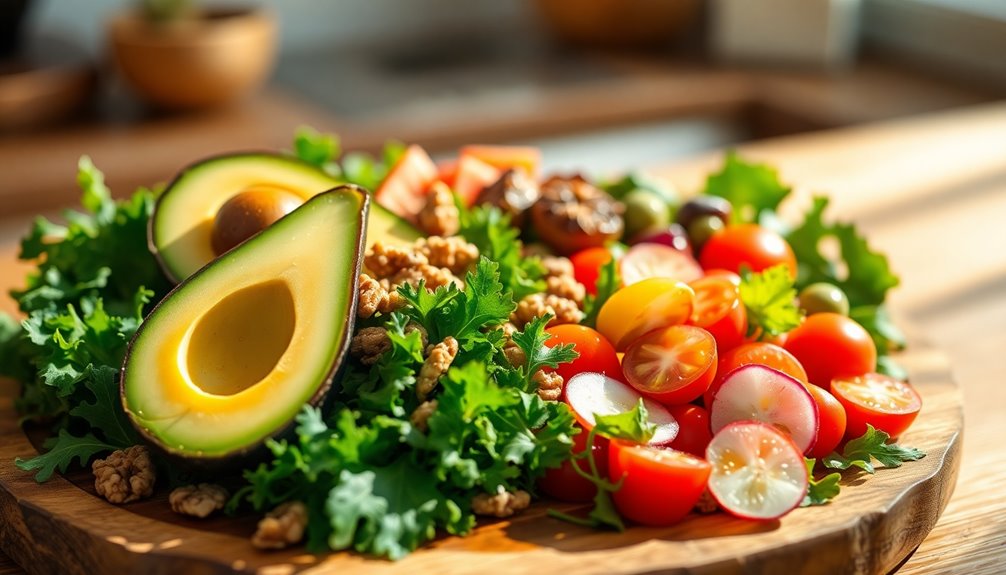Butter is a good source of fat-soluble vitamins A, D, and E, which are essential for your vision, bone health, immune system, and skin. Vitamin A helps with eye and cell health, while vitamin D supports strong bones and calcium absorption. Vitamin E acts as an antioxidant, protecting your cells and skin. The levels of these vitamins depend on factors like diet and processing. Keep exploring to discover how to maximize these nutrients in your diet.
Key Takeaways
- Butter provides essential fat-soluble vitamins A, D, and E, supporting vision, bone health, and skin protection.
- Vitamin A in butter aids vision, immune function, and skin health, especially in natural or minimally processed varieties.
- Vitamin D in butter enhances calcium absorption, vital for strong bones and overall skeletal health.
- Vitamin E acts as an antioxidant in butter, protecting cells, improving skin, and boosting immune defenses.
- Vitamin levels vary based on animal diet, season, and processing; moderate butter intake can help meet daily vitamin needs.
Understanding Fat-Soluble Vitamins and Their Importance

Understanding fat-soluble vitamins is essential because they play a crucial role in maintaining your overall health. Unlike water-soluble vitamins, these nutrients require fat for proper absorption, meaning they rely on your digestive system to effectively enter your bloodstream. Once absorbed, fat-soluble vitamins are stored in your body’s fat tissues and liver, allowing you to access them when needed without immediate intake. This storage capability means you don’t need to consume these vitamins daily, but it also highlights the importance of balanced intake to avoid deficiencies or toxicity. Recognizing how fat-soluble vitamins are absorbed and stored helps you appreciate their significance in supporting functions like vision, immune health, and cell growth. Proper nutrient absorption and storage are key to maximizing their benefits for your well-being. Emphasizing a holistic SEO approach ensures that information about these nutrients reaches and benefits a wider audience effectively.
The Role of Vitamin A in Your Health

Vitamin A plays a key role in maintaining your vision and preventing night blindness. It also supports your immune system, helping you fight off illnesses, and keeps your skin and cells healthy. Including enough vitamin A in your diet can make a noticeable difference in your overall health. Additionally, ensuring adequate intake of fat-soluble vitamins like vitamin A is important because they are stored in your body’s fat tissues and liver for future use.
Vision Support Benefits
Have you ever wondered how your body keeps your vision sharp? Vitamin A, essential for eye health, plays a key role in maintaining clear vision. Dairy nutrition, including butter, provides a natural source of this crucial vitamin. During butter processing, vitamin A is preserved, making it a convenient way to support your eyes daily. When your body has enough vitamin A, it helps prevent night blindness and dry eyes, keeping your vision crisp. Imagine this as a simple table:
| Eye Function | Vitamin A’s Role |
|---|---|
| Night Vision | Enhances rod cell function |
| Tear Production | Maintains moist eyes |
| Retina Health | Protects cells from damage |
| Visual Clarity | Sharpens image processing |
| Eye Surface | Keeps cornea healthy |
Your butter intake, along with proper dairy nutrition, helps sustain these essential functions. Additionally, understanding the impact of contrast ratio on image quality can be akin to how vitamin A influences visual sharpness, emphasizing the importance of clarity in both display technology and eye health.
Immune System Boost
Just as vitamin A supports your eye health, it also plays a vital role in strengthening your immune defenses. It helps maintain the integrity of your mucosal surfaces, which act as barriers against pathogens. When you consume butter, the fat-soluble nature of vitamin A promotes better vitamin absorption, enhancing its effectiveness. This creates a nutritional synergy that boosts your immune response, making it easier for your body to fight off infections. Adequate vitamin A levels support the production of white blood cells, key players in immune function. Consuming butter with other nutrient-rich foods ensures you get the most benefit, as this synergy maximizes vitamin A’s immune-boosting potential. Additionally, absorbing fat-soluble vitamins enhances their bioavailability, further supporting immune health. Prioritizing sources like butter can help keep your defenses strong and resilient.
Skin and Cell Health
Did you know that vitamin A is essential for maintaining healthy skin and cellular functions? It supports the repair and renewal of skin cells, helping you look vibrant. Butter provides vitamin A along with dairy protein and saturated fats, which aid in nutrient absorption. These fats help deliver vitamin A efficiently to your cells, promoting skin elasticity and protection against damage. Consuming butter in moderation ensures you get enough vitamin A without overdoing saturated fats. Incorporate it into your diet to nourish your skin from within. Here’s a quick glance at the key benefits:
| Benefit | Explanation |
|---|---|
| Skin Repair | Vitamin A speeds up cell turnover |
| Immune Defense | Supports skin barrier integrity |
| Cellular Growth | Promotes healthy cell function |
| Fat Absorption | Saturated fats enhance nutrient uptake |
| Balance | Dairy protein sustains overall health |
Additionally, fat-soluble vitamins like vitamin A require dietary fats for optimal absorption, emphasizing the importance of balanced intake.
How Vitamin D Supports Your Body

Vitamin D plays a crucial role in maintaining your overall health by helping your body absorb calcium, which is necessary for strong bones and teeth. Without enough vitamin D, your calcium absorption decreases, risking weakened bones and increased fracture risk. It also helps regulate hormones involved in various bodily functions, including immune response and cell growth. By supporting hormone regulation, vitamin D ensures your body’s systems work harmoniously. Adequate vitamin D levels can prevent conditions like osteoporosis and support overall skeletal health. Butter, being a good source of fat-soluble vitamins, provides you with this essential nutrient, especially when combined with other vitamin D-rich foods. Maintaining ideal vitamin D levels helps you stay healthy, energetic, and resilient against bone-related issues. Understanding the importance of vitamin D’s role in hormone regulation can further motivate you to include sources like butter in your diet.
The Benefits of Vitamin E and Its Functions

Vitamin E acts as a powerful antioxidant, helping protect your cells from damage caused by free radicals. It also supports healthy skin and can improve your skin’s appearance over time. Additionally, Vitamin E strengthens your immune system, keeping you better equipped to fight off illnesses. Consuming adequate amounts of nutrient-rich foods like butter can help ensure you meet your daily Vitamin E requirements.
Antioxidant Protection Role
Because butter contains significant amounts of vitamin E, it plays a crucial role in protecting your cells from oxidative damage caused by free radicals. This antioxidant helps neutralize reactive molecules, reducing oxidative stress that can damage cell membranes and DNA. By doing so, vitamin E supports your overall health and helps maintain cellular integrity. Additionally, vitamin E enhances nutrient absorption, especially of fat-soluble vitamins, ensuring your body efficiently uses other essential nutrients. Regular intake of vitamin E-rich foods like butter can bolster your body’s natural defenses against oxidative stress, which is linked to aging and chronic diseases. Incorporating butter into your diet provides a convenient way to boost your intake of this powerful antioxidant, supporting long-term health and cellular protection. Incorporating healthy fats into your diet can further improve nutrient absorption and antioxidant capacity.
Skin Health Benefits
Have you ever wondered how vitamin E can enhance your skin’s health? This powerful antioxidant helps protect your skin cells from damage caused by free radicals, which can lead to premature aging. Including vitamin E-rich butter in your diet supports skin repair and hydration. When cooking, using techniques like sautéing or spreading butter on vegetables not only boosts flavor but also preserves vitamin E’s benefits. Its anti-inflammatory properties can reduce redness and irritation, promoting a smoother complexion. Additionally, vitamin E aids in healing scars and blemishes. Incorporating butter into your meals is a simple way to maximize these skin-supporting effects while enjoying enhanced flavor. Its antioxidant properties can help neutralize environmental stressors that contribute to skin aging. Consistent intake helps maintain healthy, radiant skin, making vitamin E an essential part of your skincare routine from the inside out.
Immune System Support
Building on the skin benefits of vitamin E, this nutrient also plays a key role in supporting your immune system. It acts as an antioxidant, helping protect immune cells from damage caused by free radicals. AI-generated Vitamin E enhances your body’s ability to fight off infections by supporting proper lipid absorption, which is essential for immune cell function. However, too much vitamin E from supplements can lead to vitamin toxicity, so moderation is key. Butter provides a natural source of vitamin E, offering a safe way to boost your intake without risking toxicity. Including vitamin E-rich foods like butter in your diet can strengthen your immune defenses naturally, ensuring your body remains resilient against illness while maintaining balanced lipid absorption.
Typical Content of Vitamins A, D, and E in Butter

Butter is a notable source of fat-soluble vitamins, particularly vitamins A, D, and E. The typical content of these vitamins varies based on butter flavor profiles and butter production processes. Grass-fed butter generally contains higher levels of vitamins A and E due to the cows’ diet, while vitamin D content depends partly on sunlight exposure during production. The process of churning and the type of cream used also influence vitamin retention. Vitamin A levels in butter usually range from 150 to 200 micrograms per 100 grams, providing a significant portion of daily needs. Vitamin D content can vary from 1 to 3 micrograms per 100 grams, with fortified options offering higher amounts. Vitamin E levels typically fall between 0.5 and 1 milligram per 100 grams, making butter a modest source of this antioxidant.
Daily Values and Recommended Intake of These Vitamins

Understanding the daily values and recommended intakes for vitamins A, D, and E helps you determine how much butter can contribute to your nutritional needs. The daily values guide you in balancing butter’s vitamin content with other foods. For ideal absorption, use proper cooking techniques, such as gentle heating, to preserve vitamin levels. Storage considerations are also key; keep butter in a cool, dark place to prevent vitamin degradation over time. While butter can boost your intake of these fat-soluble vitamins, moderation is essential to avoid excess, especially for vitamin A and D. Familiarity with these guidelines helps you incorporate butter wisely into your diet, ensuring you meet your vitamin goals without overdoing it.
Factors Influencing Vitamin Levels in Butter

Several factors can substantially influence the vitamin content in butter, including the animal’s diet, the season, and the processing methods used. When animals receive a diet rich in green grasses or supplemented with vitamin D, their milk—and thus butter—contains higher levels of these nutrients. Lactation benefits, such as improved milk quality, also boost vitamin levels. Seasonal changes impact vitamin content; for example, summer milk tends to be richer in fat-soluble vitamins due to increased sunlight exposure. Butter processing methods, like churning and aging, can affect vitamin retention. Minimal processing helps preserve vitamin levels, while extensive processing may reduce them. Understanding these factors allows you to choose butter with ideal vitamin content suited to your nutritional needs.
Incorporating Butter for Optimal Vitamin Intake

To maximize your intake of fat-soluble vitamins, it’s important to incorporate butter thoughtfully into your diet. Using the right cooking techniques helps preserve vitamins, so opt for gentle methods like sautéing or melting butter over low heat. Incorporate different butter varieties, such as grass-fed or European-style, to boost vitamin D and E content. Spread butter on whole-grain bread or vegetables to enhance nutrient absorption. Adding butter to sauces, soups, or steamed dishes ensures you benefit from its vitamins without degrading their potency. Remember, the way you cook and the type of butter you choose can markedly impact your vitamin intake. By making mindful choices, you optimize butter’s nutritional value and support your overall health.
Frequently Asked Questions
Are There Any Risks Associated With Consuming Too Much Fat-Soluble Vitamins From Butter?
Consuming too much fat-soluble vitamins from butter can pose toxicity concerns, especially if you eat large amounts regularly. Excessive intake of vitamins A and D can lead to serious health issues like nausea, bone pain, and even organ damage. Plus, high doses may interfere with supplement interactions, increasing risks. It’s best to consume butter in moderation and consult a healthcare professional if you’re considering vitamin supplements to avoid these risks.
How Does Butter Compare to Other Dietary Sources of Vitamins A, D, and E?
You might think butter’s the best source for vitamins A, D, and E, but plant-based sources like leafy greens and fortified foods often provide these nutrients without the added fats. While butter supplies these vitamins naturally, fortified foods boost intake conveniently, especially for those with limited animal products. Comparing them, you get a mix of natural and added nutrients, but balance is key to avoid excessive intake from butter.
Can Vitamin Levels in Butter Vary Significantly Between Different Brands or Regions?
You might notice that vitamin levels in butter can vary because of regional differences and brand choices. Factors like local cow diets, farming practices, and processing methods influence vitamin content. So, depending on where you buy your butter and the brand you choose, the amounts of vitamins A, D, and E can differ quite a bit. Always check labels or regional info if you’re aiming for specific nutrient intake.
Is Butter a Suitable Source of These Vitamins for People With Lactose Intolerance?
If you have lactose intolerance, butter can still be a good source of vitamins A, D, and E because it contains minimal lactose. However, if dairy causes you issues, consider dairy alternatives fortified with these vitamins. Always check labels to verify you’re meeting your vitamin needs without triggering symptoms. So, butter might work for some, but dairy alternatives are a safer choice for others with lactose intolerance.
How Do Cooking Methods Affect the Vitamin Content in Butter?
Cooking techniques markedly influence vitamin stability in butter. When you heat butter at high temperatures or for extended periods, it can cause some loss of fat-soluble vitamins like A, D, and E. To preserve these nutrients, opt for gentle cooking methods such as low-temperature sautéing or adding butter at the end of your cooking process. This way, you retain more vitamins and maximize the nutritional benefits of butter.
Conclusion
Did you know that a tablespoon of butter can provide about 11% of your daily vitamin A needs? By understanding the vitamin content in butter, you can make smarter dietary choices. Incorporating butter into your meals not only adds flavor but also boosts your intake of essential fat-soluble vitamins. Just remember, moderation is key—balance butter with other nutrient-rich foods to support your overall health and wellness.










